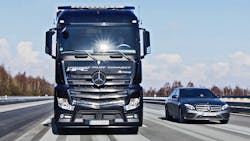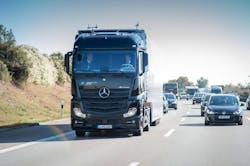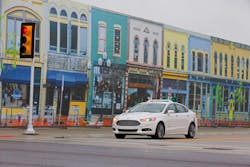Even as the development and testing of self-driving cars and commercial trucks accelerates at a rapid pace – with regulators aiming to help speed up their deployment – there’s growing debate over whether the motoring public and fleets will be accepting of autonomous vehicles (AVs) and, if so, how such acceptance could ultimately alter the shape of future transportation networks.
“AVs may be here sooner than we think, for there are lots of positive things the can provide: safer roadways, more independent transportation for the blind and disabled, etc.,” Howard Jennings, managing director of the Mobility Lab, explained to Fleet Owner.
“But because we are so focused on the technology and what it can do, there are many unanswered questions, especially in terms of how the market will respond,” he noted. “Will the number of single-car trips go up or down? Will it result in higher VMT [vehicle miles traveled]? What will be the impact on our communities? Will that lead to more urban sprawl? We don’t know that for sure,” Jennings said.
[By extension, that might alter transportation demand management efforts as well.]
On the fleet side of the ledger, many seem dubious – at least at this point in time – that self-driving trucks will be deployed in significant numbers anytime soon.
“The self-driving trucks are the ones that people are the most skeptical about,” Steve Sashihara, founder and CEO of Princeton Consultants, recently noted in a conference call hosted by Stifel Financial Corp.
“There are some people that believe this is definitely going to happen but there arPrinceton conducted a fleet survey on the topic of self-driving trucks and found that 24% believe they will have no real impact, with 48% thinking their impact will be limited to “small niches.” By contrast, just 23% said AVs will have at least “moderate” impact on trucking and only 5% believe they’ll have a “large impact.”
“I think that due to the high amount of visibility, people are now slanting more and more toward ‘maybe this is coming sooner than we think,’ but maybe not,” Sashihara said.
[Some of that “high visibility” results from very splashy public demonstrations of self-piloting vehicles, like this one hosted by Daimler AG in Germany back in March.]
“On the survey results a good 24% said that eight years from now there really won’t be much of a real impact – maybe some more experiments but nothing really happening,” he pointed out. “Only 5% said that [AVs would] probably have a large impact and be fairly common.”
However, others taking a longer view of the self-driving vehicle think it will eventually become a primary mode of transportation, especially in terms of personal mobility.
“By mid-century, the practice of someone primarily driving himself or herself around town in a gasoline car will be as unusual as traveling by horse and buggy is today,” stressed John Gartner, senior research director with Navigant Research noted in the firm’s recent Transportation Outlook: 2025 to 2050 report.“Instead, the combination and intersection of autonomous, shared, connected, and electric vehicle technologies will contribute to the gradual reduction of the number of cars on the road beginning in the 2030s that is already prompting automakers to expand to a variety of new mobility as a service business models,” he said
Gartner for one believes the development of car-sharing and ride-hailing services is at the core of a trend toward “on-demand mobility” that veers away from individual vehicle ownership, which is expected to gradually decline in popularity as mobility services expand.
But how will such a shift impact the layout of cities and other urban centers? Mobility Lab’s Jennings, for one, fears the focus on self-driving cars may reverse trends focused on “mixed use” downtown designs that encourage bicycling, walking, and the use of public transit.
“Do we lose the ‘multi-model’ focus we’ve been bringing to city design over the last few decades?” he asked. “And what happens to the car after you’ve been delivered to your destination? Does it go back home? Does it park itself somewhere? Does that mean more empty trips and more demand for parking spaces?”
On the truck side, Princeton’s Sashihara sees a different set of issues developing; ones that in many cases may favor the deployment of self-driving trucks over the long term.
“In terms of tailwinds – things that are propelling us forward for long-haul freight transportation – approximately a third of the cost of truckload transportation are drivers,” he said. “We have an aging driver population and a long-term [driver] shortage; so there’s seems to be a compelling business case.”
To Sashihara’s mind, then, deployment of self-driving trucks will occur in three phases:
- First, there will still be a driver in the seat but with self-braking and self-piloting cruise control. “Will hours of service be counted? Who knows, but we think that’s a ‘toe-in-the-water’ that will propel the idea that this is possible,” he explained.
- The second phase involves platooning trucks. “This where there will be truly self-driving trucks in certain areas, he noted. “We think that’s a perfect way of doing freight transportation. In fact, I would use as an analogy rail intermodal: so think of self-driving trucks [in a platoon] running down highways, maybe off-peak, maybe at night. Think of that as the ‘rail-leg.’ Then they could park at the end and have a real dray-driver, with a conventional rig, pick up the 53-ft. trailer and just drop it off and bring back a load.”
- The third phase occurs when people view self-driving trucks as a full, door-to-door delivery system, he says, and will happen when people stop saying “when will this technology be safe enough.” Sashihara believes that when people start saying “self-driving trucks are actually safer” than human operated trucks, then there will be a rush towards them. “In fact, you might have people insisting on it,” he added.
About the Author
Sean Kilcarr
Editor in Chief
Sean Kilcarr is a former longtime FleetOwner senior editor who wrote for the publication from 2000 to 2018. He served as editor-in-chief from 2017 to 2018.


